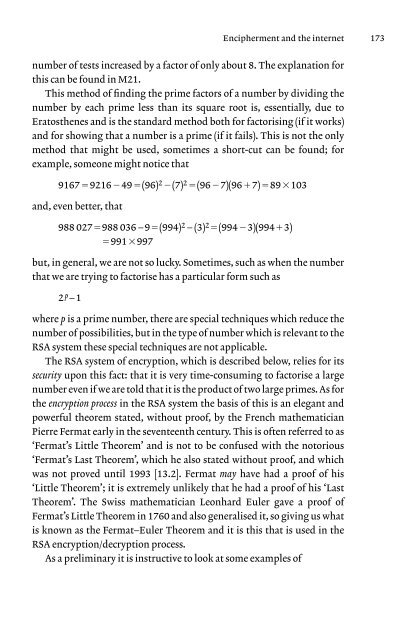Code and ciphers: Julius Caesar, the Enigma and the internet
Code and ciphers: Julius Caesar, the Enigma and the internet
Code and ciphers: Julius Caesar, the Enigma and the internet
You also want an ePaper? Increase the reach of your titles
YUMPU automatically turns print PDFs into web optimized ePapers that Google loves.
number of tests increased by a factor of only about 8. The explanation for<br />
this can be found in M21.<br />
This method of finding <strong>the</strong> prime factors of a number by dividing <strong>the</strong><br />
number by each prime less than its square root is, essentially, due to<br />
Eratos<strong>the</strong>nes <strong>and</strong> is <strong>the</strong> st<strong>and</strong>ard method both for factorising (if it works)<br />
<strong>and</strong> for showing that a number is a prime (if it fails). This is not <strong>the</strong> only<br />
method that might be used, sometimes a short-cut can be found; for<br />
example, someone might notice that<br />
9167�9216�49�(96) 2 �(7) 2 �(96�7)(96�7)�89�103<br />
<strong>and</strong>, even better, that<br />
988 027�988 036 – 9�(994) 2 – (3) 2 �(994�3)(994�3)<br />
�991�997<br />
but, in general, we are not so lucky. Sometimes, such as when <strong>the</strong> number<br />
that we are trying to factorise has a particular form such as<br />
2 p –1<br />
Encipherment <strong>and</strong> <strong>the</strong> <strong>internet</strong> 173<br />
where p is a prime number, <strong>the</strong>re are special techniques which reduce <strong>the</strong><br />
number of possibilities, but in <strong>the</strong> type of number which is relevant to <strong>the</strong><br />
RSA system <strong>the</strong>se special techniques are not applicable.<br />
The RSA system of encryption, which is described below, relies for its<br />
security upon this fact: that it is very time-consuming to factorise a large<br />
number even if we are told that it is <strong>the</strong> product of two large primes. As for<br />
<strong>the</strong> encryption process in <strong>the</strong> RSA system <strong>the</strong> basis of this is an elegant <strong>and</strong><br />
powerful <strong>the</strong>orem stated, without proof, by <strong>the</strong> French ma<strong>the</strong>matician<br />
Pierre Fermat early in <strong>the</strong> seventeenth century. This is often referred to as<br />
‘Fermat’s Little Theorem’ <strong>and</strong> is not to be confused with <strong>the</strong> notorious<br />
‘Fermat’s Last Theorem’, which he also stated without proof, <strong>and</strong> which<br />
was not proved until 1993 [13.2]. Fermat may have had a proof of his<br />
‘Little Theorem’; it is extremely unlikely that he had a proof of his ‘Last<br />
Theorem’. The Swiss ma<strong>the</strong>matician Leonhard Euler gave a proof of<br />
Fermat’s Little Theorem in 1760 <strong>and</strong> also generalised it, so giving us what<br />
is known as <strong>the</strong> Fermat–Euler Theorem <strong>and</strong> it is this that is used in <strong>the</strong><br />
RSA encryption/decryption process.<br />
As a preliminary it is instructive to look at some examples of

















